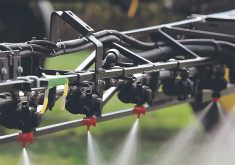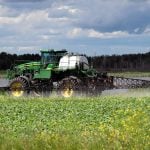Three large barn fires that have killed almost 30,000 hogs this year have sparked discussions about whether construction codes should be applied to large industrial farms.
Manitoba deputy fire commissioner Mike Jones said that in the coming weeks the Office of the Fire Commissioner (OFC) will hold talks with key stakeholders, including Keystone Agricultural Producers, the Manitoba Pork Council, representatives from the insurance industry and rural municipalities, about the possible need for improved standards.
“We’re not tying anyone’s hands, but we need to have the discussions and determine as a group whether there is a need or if there might be alternatives,” said Jones.
Read Also

Fall rye hits record high in Manitoba
Winter cereals 2025: More Manitoba fields grew fall rye in 2025 than ever before, but winter wheat slipped and, while spring stand survival was good, drought took its toll
Farm buildings are exempt under the Building and Mobile Homes Act and are not required to have fire prevention systems such as sprinklers and firewalls.
Currently, the industry takes care of itself, based on self-interest and the fact that insurers won’t sell coverage to barns that don’t have adequate fire control measures.
A recent fire east of Zhoda, Man., that saw 6,500 sows die in a facility owned by Maple Leaf Agri-Farms was the third incident since the beginning of the year. It followed a blaze near Sarto in May that killed 15,000 pigs in a Hytek facility, and an April fire at the Netley Hutterite Colony in which 8,700 hogs died.
The estimated cost of the fires has been pegged at $25.5 million, according to the OFC.
In 2007, statistics from the OFC showed 3,700 hogs died in six fires. Each year since 2002, the province has recorded as few as six hog barn fires to as many as nine, with an average of about 3,000 animals killed each year.
Jones said that 1999 was the worst year for fires in recent memory, with estimated losses of around $15 million.
Investigators have ruled most fires accidental, blaming mainly electrical and some mechanical failures. Arson has been recorded in barn fires over the past 10 to 20 years, but Jones said such incidents are “very, very rare.”
Mike Teillet, manager of sustainable development with the Manitoba Pork Council, said his organization is not opposed to a farm building code.
“Anything recently built in the last 15 to 20 years has been designed by a professional engineer. While they are not legally subject to conform to the building code, many of them are constructed to similar standards,” said Teillet.
“The insurance companies require them to be subject to a pretty tough standard.”
People are naturally suspicious that some fires have been intentionally set, said Teillet, because the unusually high losses have come amid the threat of a permanent moratorium on barn expansion in some areas, rock-bottom prices and high feed costs.
“We just think that it’s a weird coincidence that it is happening right now,” he said, adding that corporate or Hutterite operators in particular would gain nothing from a fire.
Barn fires and hog losses may follow cyclical downturns in the industry, but the reason for that is unlikely to be the one often cited by coffee row gossips, said Richard Barnabe, president of Barnabe Saurette Insurance, one of the province’s largest insurance brokers covering the agriculture industry.
“The notion that a large hog farmer would burn down his barn voluntarily to make money is extremely suspect because there likely is very little money to be made,” said Barnabe.
An insurance payout is based on the actual cash value of the building, livestock and business income lost.
“Let’s say he burns it down and rebuilds it – duh – what did he gain there? If the hog industry is in a tailspin, and hog barns aren’t worth anything because nobody wants to buy them, well, guess what they are worth? Not much.”
If a barn is destroyed in a fire and the farmer decides not to rebuild, then the insurer is not obligated to cover business interruption losses, he added.
That fires seem to occur amid tough times could be explained by the tendency by operators to cut back on regularly scheduled upgrades and equipment improvements.
An operator faced with losses as high as $50 per head may try to hold off on replacing aging heater units, for example, despite the increased risk of fire.
“If the farmer is bleeding like crazy, he’s not going to be putting a ton of money into the facility, is he?” said Barnabe.














